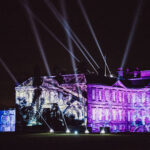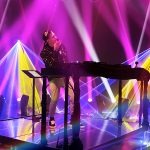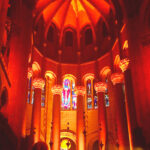 Once again over 100 million people from 180 countries tuned in to watch the Super Bowl and its infamous halftime show, as Justin Timberlake played a 13-minute set revealing a new song and plenty of his hits. It was his third Super Bowl appearance, but first as a headliner. A crack squad of technicians and I.A.T.S.E. members were able to set the stages on the field in approximately six minutes. Considering there were seven different performance stations for Timberlake, this was a feat that took some serious planning.
Once again over 100 million people from 180 countries tuned in to watch the Super Bowl and its infamous halftime show, as Justin Timberlake played a 13-minute set revealing a new song and plenty of his hits. It was his third Super Bowl appearance, but first as a headliner. A crack squad of technicians and I.A.T.S.E. members were able to set the stages on the field in approximately six minutes. Considering there were seven different performance stations for Timberlake, this was a feat that took some serious planning.
Producer Ricky Kirshner’s Touchdown Entertainment team, director Hamish Hamilton, production designer Bruce Rodgers and his group from Tribe worked out the staging details with Timberlake’s design team, headed by Nick Whitehouse, ahead of time. Lighting designer Bob Barnhart from the entertainment design firm 22° lit the show for the 20th time in his career, working in conjunction with Nick and the team from Fireplay. All Access was once again in charge of the staging elements and moving gear into place. PRG supplied the lighting while video elements came from VER. Strictly FX looked after the lasers and special effects. Glow Motion Technologies was on hand to spread wireless LED battens on the field as well as in the stands. Their gear has become a staple of the halftime show in recent years.

A Solo (but Crowded) Show
It was announced before the date that there would be no special guests sharing the field. But the span of the field was used. Timberlake covered major real estate from top to finish. The show started in a makeshift club set up under the stands in the Minneapolis’ US Bank stadium, home of the NFL’s Vikings. While officially called the Delta Club, the techs referred to it as the Laser Lounge, due to the incredible display of beams provided by a squad from Strictly FX. The small club featured Justin starting out with a new song and backed by 67 GLP impression X1’s, some Rush pars and a smattering of Robe Robin 600 fixtures for keys and a video wall.

After a minute of new music — highlighting the song, “Filthy,” off of JT’s Jan. 2018 album release, Man of the Woods — the artist worked his way up a ramp to the outside. Upon entering the stadium and being lit, the singer and dancers worked the second stage to the tune of “Rock Your Body” with a custom ramp that All Access had built for the artist to get down to the field. The ramp was lined with 30 GLP impression X4’s. Barnhart had also positioned 13 followspots in the system to pick up Timberlake from any angle.
Upon hitting the field, the troupe went straight to what was called the Dive Stage — a small compact platform that had four Robe PATT fixtures built into it, while another five of the fixtures were set to face the camera while held in place by Crank-O-Vator lifts. Barely stopping to catch his breath, the singer announced his long-time band, the Tennessee Kids, as the main stage turned the production up in spectacular fashion, with a medley of “SexyBack,” “My Love” and “Cry Me a River.”
The main stage was custom-built by All Access and held a large number of video panels that resembled cubes. These video flats surrounded the musicians as Timberlake worked the stage 360°. More of the VER video product was used behind the stage, lining the field in an array for great
camera shots. Gabriel Coutu-Dumont and J.T. Rooney with Silent Partners Studio provided all the media content.
 Silver Sharpys ran along the deck while four truss carts lined the back of the stage with a plethora of dazzling fixtures. Along with 74 GLP GT-1s, the center wall behind the stage included 20 GLP X4 Bar 20 fixtures, aligned in two long rows, with 80 JDC1 strobes forming two additional horizontal rows of fixtures. A single row of Claypaky Sharpys lined the center.
Silver Sharpys ran along the deck while four truss carts lined the back of the stage with a plethora of dazzling fixtures. Along with 74 GLP GT-1s, the center wall behind the stage included 20 GLP X4 Bar 20 fixtures, aligned in two long rows, with 80 JDC1 strobes forming two additional horizontal rows of fixtures. A single row of Claypaky Sharpys lined the center.
After spending a few minutes dancing with his band, Timberlake headed off to the Diamond stage for a song. Bruce Rodgers had a concept that called for a small white platform that glowed from within. All Access built the perfect diamond shaped two step stage to prop him off the field. The box was evenly illuminated with LED tape from within. Built in the center was a mechanical device that held a mic stand the singer could play with. Kicking it over and wrapping it around his body, the stand would always pop back up straight with impeccable timing. The ease in which he mastered this gag was phenomenal. The tuxedo-clad University of Minnesota marching band was brought into the choreographed act, performing “Suit and Tie” as Timberlake announced it was time to “Let the horns say it.”
Next up came time for a little tribute to the city of Minneapolis and its favorite hometown hero, Prince. A single white piano was mounted on top of two white disks, the circumference of which was lined with LED tape. Simple but effective. Barnhart had the front of the piano lined with white LED tape, enabling him to turn off the house spots he had been using for key light on Justin and allow the star and his circular disks be the only thing illuminated on the field at that time. They appeared to be floating.

Tribute to Prince
An audible gasp could be heard followed by cheers, as a white fabric unfurled from the rafters and imagery of Prince appeared. Justin sang along as they did a duet of “I Would Die 4 U.” Projecting on to a flowing fabric was quite a task, but through repeated practice, the gag came off flawlessly and the hands defeated the air handlers. For the lighting segment of the piano bits, the design called for eight Weston dollies to half-circle the round stage. Each dolly held two PRG Bad Boy spot fixtures, a DF-50 hazer and a fan.
Interestingly, it was Timberlake himself who originally suggested, “Wouldn’t it be great if we could turn all of Minneapolis purple during this segment?” Rumors abounded that the production team somehow accomplished this by contacting everyone that was lighting any structure in town and giving them some instructions. More than likely some TV folks shaded the helicopter shot with some purple color. At the last possible moment, the helicopter shot caught more purple lights that popped on brighter than the others and made up the infamous Prince logo. The marvels of modern technology. It may have aided the whole process and dealing with Prince’s estate with media content, that Bruce and Bob had worked with the artist on his own legendary halftime show in 2007.
 After the piano bit, the singer turned it up a notch, returning to the main stage to perform “Mirrors.” The stage now had a large glass-and-mirrored looking structure in the center that Timberlake stood atop of. At this point, the stage was surrounded by people holding square mirrored panels for a huge mirror-ball effect in the middle of the field. Choreographer Kristen Terry had her hands full directing this segment. Lighting with mirrors is a lot harder to accomplish than it looks. The best solution the team came up with was to tell the dancers to point the mirrors in the direction of the cameras themselves with hopes that the light beams would catch the lens. They did.
After the piano bit, the singer turned it up a notch, returning to the main stage to perform “Mirrors.” The stage now had a large glass-and-mirrored looking structure in the center that Timberlake stood atop of. At this point, the stage was surrounded by people holding square mirrored panels for a huge mirror-ball effect in the middle of the field. Choreographer Kristen Terry had her hands full directing this segment. Lighting with mirrors is a lot harder to accomplish than it looks. The best solution the team came up with was to tell the dancers to point the mirrors in the direction of the cameras themselves with hopes that the light beams would catch the lens. They did.
Shifting into the finale, the crowd-pleasing hit, “Can’t Stop the Feeling,” the pure white beams turned into a rainbow of various colors and the crowd holding the mirrored panels flipped them to reveal their colorful undersides, and the whole entourage followed a lit trail across the field and up into the stands, where the Timberlake partied and took selfies in the crowd, giving one kid instant fame. And the show that started in a dimly lit club ended up in a fully lit stadium.

The Build for the Show
The build for the show started 16 days prior to the event. Lighting-wise, a giant rectangular truss box was erected over the field, hung by Stage Rigging. This box was staggered with VL4000 BeamWash fixtures and PRG Icon Edge fixtures. The Vari-Lites illuminated the audience while the Icons worked the field.
Rail space to hang lighting fixtures from was not in abundance at this stadium. But they did find enough room to mount one long line of fixtures, up behind the main stage. Along the main line was a row of Solaris Flare wash strobes, alternating with more PRG Icon Edge fixtures. Best Boy HP fixtures were tucked into areas on the other side to provide key light. Chris Conti from PRG was tasked with networking every lighting station together, among his many hats. He reported that it took 12,000 feet of fiber cable to achieve this task.
The stages were all assembled and stored in a tent outdoors on the stadium grounds. With the Minnesota temperatures outside dropping to -13°F during the setup, this had to bring its share of challenges. Among the carts that were wheeled on to the field were 16 audio carts that surrounded the circumference of the playing field. Along with the P.A., each cart held two GLP GT-1 fixtures.
What wasn’t noticeable on TV was that, after each stage was used, a team of people descended upon it and began to strike it as the action moved to another part of the field.
The logistics along with job titles for an event of this magnitude is almost endless. From a Mirror technician to the guy that handles all the routing of the vehicles, the only way for a gig of this magnitude to run smoothly is if everyone executes their role, no matter how minute it may be, flawlessly.


